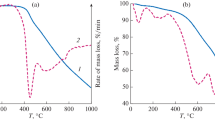Chromatography/mass spectrometry (GS/MS) was used to study toluene-soluble (TS) and pyridine-soluble (PS) fractions obtained from coal liquefaction residue by solvent extraction. It was found that the toluene-soluble fraction, containing mainly polycyclic aromatic hydrocarbons with 2-4 rings, is a good feedstock for making needle coke. The pyridine-soluble fraction cannot be used for these purposes because it contains more aromatic hydrocarbons with 5 or more rings. The composition of the studied samples determines their different behavior in carbonization (coking).



Similar content being viewed by others
References
R. García, A. Arenillas, F. Rubiera, and S. R. Moinelo, “Supercritical gas extracts from low quality coals: on the search of new precursors for carbon materials,” Fuel Processing Technology, 86, 205–222 (2004).
J. L. Li, P. G. Stansberry, J. W. Zondlo, and A. H. Stiller, “Characteristics and carbonization behaviors of coal extracts,” Fuel Processing Technology, 79, 205–222 (2002).
M. H. Makgato, L. J. Moitsheki, and L. Shoko, “Alkali-assisted coal extraction with polar aprotic solvents,” Fuel Processing Technology, 90, 591–598 (2009).
D. Smook, “Removal of mineral material from solvent-refined coal by solvent extractions,” Fuel Processing Technology, 88, 795–798 (2007).
H. F. Shui, Z. C. Wang, and G. Q. Wang, “Effect of hydrothermal treatment on the extraction of coal in the CS2/NMP mixed solvent,” Fuel, 85, 1798–1802 (2006).
F. Rodriguez-Reinoso, P. Santana, E. Romero Palazon, M.-A Diez, and H. Marsh, “Delayed coking: Industrial and laboratory aspects,” Carbon, 36, 105–116 (1998).
H. P. Zhang, “Formation mechanism of needle coke from heavy aromatic hydrocarbons,” Tansu Jishu, 23, 28–33 (2004).
I. Mochida, K. Fujimoto, and T. Oyama, in: P. A. Thrower, ed., Chemistry and Physics of Carbon, Dekker, New York (1994), pp. 145–150.
X. L. Cheng, Q. F. Zha, X. J. Li, and X. J. Yang, “Modified characteristics of mesophase pitch prepared from coal tar pitch by adding waste polystyrene,” Fuel Processing Technology, 89, 1436–1441 (2008).
X. L. Cheng, Q. F. Zha, J. J. Zhong, B. H. Hou, and Y. S. Guo, “Influences of alkyl group on the formation of needle coke,” Journal of Fuel Chemistry and Technology, 37, 166–169 (2009).
I. Mochida, Y. Korai, C. H. Ku, F. Watanabe et al., “Chemistry of synthesis, structure, preparation and application of aromatic-derived pitch,” Carbon, 38, 305–328 (2000).
X. L. Cheng, Q. F. Zha, J. T. Zhong, and X. J. Yang, “Needle coke formation derived from co-carbonization of ethylene tar pitch and polystyrene,” Fuel, 88, 2188–2192 (2009).
G. L. Wang, R. Xu, D. X. Zhang, and X. L. Lu, “The hydrogenation of coal liquefaction residue,” Acta Petrolelei Sinica (Petroleum Processing Section), 25, 747–751 (2009).
M. Poot and R. C. Everson, “Extraction of coal tar pitches with toluene near the critical point: gasification and hydrogenated pitches,” Fuel, 78, 1017–1025 (1999).
Steven Sai Hang Ho, Judith C. Chow, John G. Watson, Louisa Pan Ting Ng et al., “Precautions for in-injection port thermal desorption-gas chromatography/mass spectrometry (TD-GC/MS) as applied to aerosol filter samples,” Atmospheric Environment, 45, 1491–1496 (2011).
I. Mochida and Y. Korai, “Semi-quantitative correlation between optical anisotropy and CTE of needle-like coke grains,” Carbon, 25, 273–278 (1987).
P.A. Lefrank, S. L. Hoff, and J. J. Stefanelli, “Correlation of structure SEM data of cokes with graphite,” Carbon, 27, 945–949 (1989).
Author information
Authors and Affiliations
Corresponding author
Additional information
Translated from Khimiya i Tekhnologiya Topliv i Masel, No. 5, pp. 11 – 14, September – October, 2012.
Rights and permissions
About this article
Cite this article
Cheng, X., Li, G., Peng, Y. et al. Obtaining needle coke from coal liquefaction residue. Chem Technol Fuels Oils 48, 349–355 (2012). https://doi.org/10.1007/s10553-012-0379-3
Published:
Issue Date:
DOI: https://doi.org/10.1007/s10553-012-0379-3



